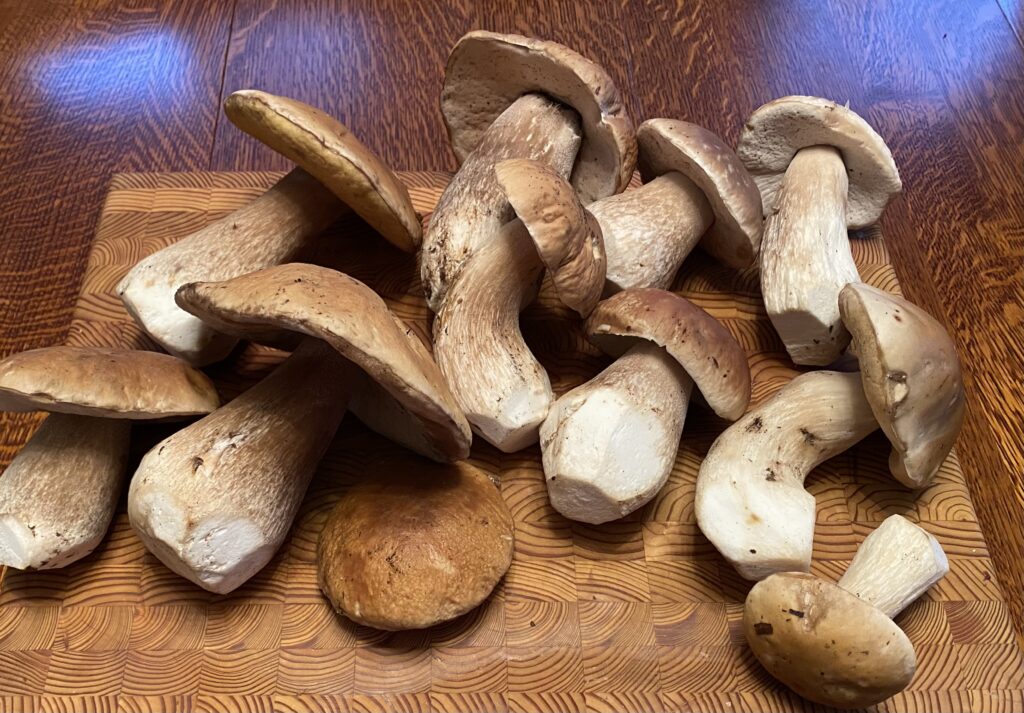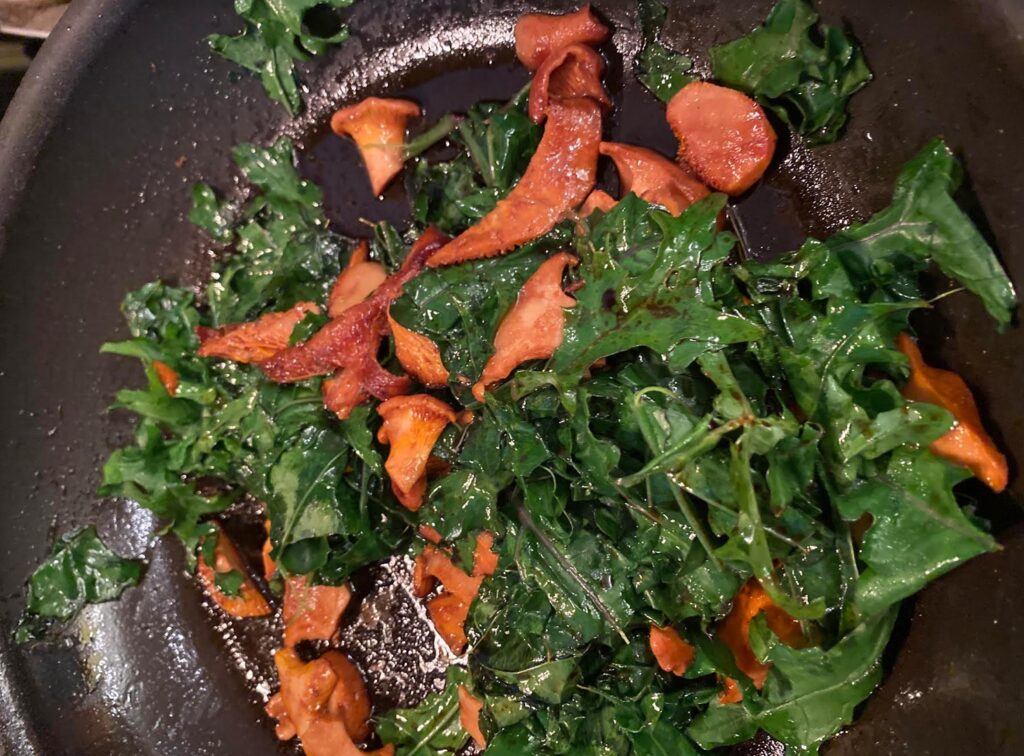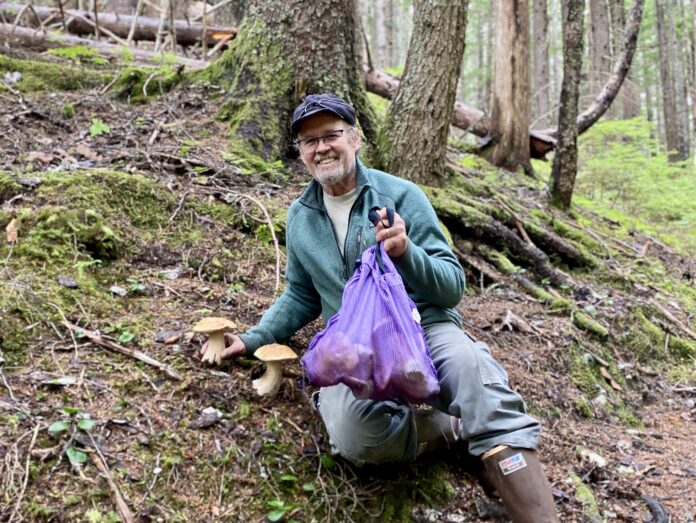By BRENDA JOSEPHSON
This time of the year Alaskans become focused on gathering food, fishing, and hunting in preparation for winter. Now that autumn has fully arrived, it is the perfect time to go mushroom hunting for a nutritious and savory complement to your meals.
Alaska’s abundant spruce forests are home to a wide variety of fungi, including numerous edible mushrooms. These include the Pacific Golden Chanterelle (Cantharellus formosus), Comb Tooth (Hericium coralloides), Hedgehog (Hydnum repandum), Bear’s-head (Hericium abietis), Gray Fire Morel (Morchella tomentosa), Shaggy Mane (Coprinus comatus), Chicken-of-the-Woods (Laetiporus conifericola), several varieties of the Boletes family (Boletaceae), and more.
Judy Hall Jacobson has written several books about foraging wild edibles in Alaska. One of her books, “Mushrooms and Other Fungi of Alaska,” is an in-depth guide to identification, edibility, and gathering in our region.
Jacobson says, “Fifty percent of mushrooms are inedible, either too tough like most woody shelf fungi, indigestible, or too small to consider eating. In comparison, twenty-five percent are edible but unpleasant or tasteless. Twenty percent will make you sick, but your body will get rid of the toxins. However, it will not be a pleasant experience. A mere one percent can kill you.”
Jacobson’s research has led her to conclude that when it comes to Alaska’s fungi, “four percent are tasty.”
Make sure to properly cook fungi before eating them. Unlike plants, mushrooms have cell walls that contain chiton. Shellfish and insect exoskeletons are also chitinous. Heat breaks down chiton, releasing the vitamins, proteins, and other nutrients found in fungi. Cooking is also necessary for food safety reasons. Jacobson cautions that hydrazine, a suspected carcinogen used in rocket fuel, is present in most, if not all, fungi, including the Button mushroom (Agaricus bispora) frequently sold in grocery stores. Cooking breaks down hydrazine.
To begin honing your mushroom hunting skills, start by ensuring your safety in the woods by being alert to the possible presence of bears and moose. Carry bear spray, a loud horn, a communication device, and a firearm if you are comfortable using one.
While foraging, be mindful of the environment. Make sure not to overharvest in one location. When gathering, using a mesh bag or basket helps fungi propagate by spreading spores throughout the forest on your trek. Learn about a few identifiable mushroom species that are common in your area but do not have toxic lookalikes. As you hike through the forest, pay close attention to your surroundings, and you will be on your way to identifying when and where you can find edible fungi.
For example, it is possible to find Hedgehogs under coniferous trees throughout the mushroom season. Chanterelles can be found in both moist areas near streams and wooded areas from August through November. King Boletes often grow in areas under spruce trees during their shorter growing season in September and October. Recent rainfall tends to promote fungi growth and increases your chances of a successful hunt.
Jacobson, a dedicated “shroomer,” lists her favorite mushrooms as the King Bolete (Boletus edulis) due to taste and Hedgehog (Hydnum repandum) due to taste and because they stay firm for days after fruiting. Some of her other top choices include the Sheep Polypore, (Albatrellus ovinus), Woodland Agaricus (Agaicus silvicola), and Cauliflower Mushroom (Sparassis radicata).
Her other guidebook, Edible Mushrooms of Alaska, provides in-depth knowledge of edible species present in Alaska.

King Boletes are widespread in Alaska and the Yukon. This royal-sized mushroom has a spore-bearing layer on the underside of the cap that contains pores rather than gills or teeth. It is most enjoyable when the cap is small, firm, and harvested before insect and centipede infestations.
The King Bolete’s meaty flesh and mild flavor complement hearty game dishes and stews. It is also enjoyable as its own side dish. While freshly gathered and cooked is the best way to enjoy this species, it also preserves well in a dehydrator. You can easily rehydrate and prepare dried King Boletes to add flavor and texture to a variety of soups, sauces, and dishes.
Hedgehogs are also known as the Sweet Tooth mushroom. This species is easily identifiable due to the soft toothlike spines on the underside of their caps, which resemble Hedgehog spikes. When cooked, Hedgehogs stay firm and have a sweet and nutty flavor that is enjoyable on its own or as a complement to any dish or soup. Cooked Hedgehogs hold up well in the freezer for use at a later date.
The Pacific Golden Chanterelle is popular among foragers in Southeast Alaska. However, foragers typically do not find this species further north. Chanterelles have a bright yellow or pale orange cap. Instead of gills, the cap bears its spores on ridges or well-developed folds.
Because of their high moisture content, cook them using a ‘dry sauté’ method, followed by sautéing in butter or oil and seasoning with salt, pepper, and other desired seasonings until they caramelize. Chanterelles have a robust flavor, with a hint of peppery fruit. They brighten a warm dish of wilted kale and/or spinach, as well as adding a velvety texture and taste sensation to pasta dishes. Chanterelles also make a hearty side dish served on their own.
All too often, our plates are filled with processed foods from faraway places. So, before you head into the woods this fall, grab a foraging guidebook or download an app to arm yourself with knowledge about edible mushrooms and bring home some fungi. Foraging is a wonderful way to connect with nature, learn more about our unique ecosystem, gain inspiration from our region’s unique offerings, and savor the local flavors and textures that Alaska has to offer.

Wilted Kale Chanterelles
Ingredients:
- 8 ounces of Chanterelle mushrooms (Cantharellus formosus)
- 1 ounce of butter
- 2 cloves of garlic, minced
- 2 tablespoons of olive oil
- 3 ounces of white wine (divided into 2 – 1 ½ ounce shots)
- 1 pound of young kale, coarsely chopped
- 1/3 cup of vegetable stock or bone broth
- Salt and Pepper
Preparation:
- Place the Chanterelle mushrooms in a large dry sauté pan on medium-high heat and cook until the moisture evaporates from the mushrooms and they squeak when tossed with a spatula.
- Add butter and a pinch of salt and pepper, stirring to ensure even cooking until almost caramelized.
- Add garlic and olive oil, cook until the garlic becomes soft and the mushrooms are caramelized.
- Add half of the wine (1 ½ ounces or one shot), stirring occasionally until the wine evaporates.
- Raise the heat to high, then add the vegetable/bone broth and kale.
- Cover and cook for 3 to 5 minutes to wilt the kale.
- Remove the cover, continue cooking on high heat, stirring constantly until the liquid evaporates.
- Add the final half of the wine (1 ½ ounces or one shot) and a pinch of salt and pepper to taste.
- Remove from heat and serve.
Brenda Josephson is a Haines resident. She is an accounting and tax professional, real estate agent, professionally trained chef, and advocate for good governance. She spends her time fishing, foraging, and savoring Alaska’s abundance of natural and wild foods with her family.

Thank you so much, Brenda. Your article is a much needed reprieve from politics.
??
An appetizing reminder of one of the many ways we are blessed to live in Alaska! What a great addition to MRA.